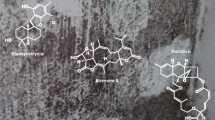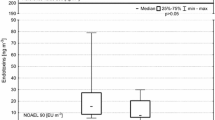Summary
Analysis of trichothecene mycotoxins in dust samples from ventilation systems of office buildings was applied as a rapid and inexpensive method for the detection of mycotoxins. Dust samples from three different office spaces of the Montreal urban area, reportedly affected by the “sick buildings syndrome”, were analysed by thin-layer chromatography (TLC). Positive colour reaction on TLC plates with 4-(p-nitrobenzyl) pyridine, specific for the 12,13-epoxy group in the trichothecene nucleus, was obtained for the extracts of 0.5- to 50-g dust samples. The dust samples contained at least four trichothecenes: T-2 toxin, diacetoxyscirpenol, roridine A and T-2 tetraol. The results were confirmed by high-performance liquid chromatography analysis. Screening of dust samples from air ventilation systems of reportedly affected buildings provided direct evidence of trichothecene mycotoxins, with the detection limit estimated as 0.4-4 ng/mg dust. Thus, the dust sample analysis is suggested as a rapid technique for detecting the presence of mycotoxins in the dust of ventilation systems.
Similar content being viewed by others
References
Auger P, Aberman A, Copeland D, Mainville C (1991) Poussiere toxigenique vs syndromes organique et de fatigue chronique. Open letter, Service du génie industriel de la CSN, Montreal, Quebec
Blaszczyk M, Boileau S, Forunier M, Chevalier G, Krzystyniak K (1987) Growth of facultative anaerobic population of human intestinal bacteria with the carbamate pesticide aminocarb. Pestic Biochem Physiol 29:233–243
Boutard A, Smoragiewicz W, Dupont S (1990) La contamination de fair par les moissures: négligeable ou negligée? Travail et Santé 6:5–10
Cossette B, Smoragiewicz W, Boutard A, Bouchard G (1992) La détection des mycotoxines trichothécènes. Travail et Santé 8:2–6
Cresia D, Thurman JD, Jones L, Neally M, York C, Wannemacher RW, Bunner DL (1987) Acute inhalation toxicity of T2 mycotoxin in mice. Fundam Appl Toxicol 8:230–235
Croft WA, Jarvis BB, Yatawara CS (1986) Airborne outbreak of trichothecene toxicosis. Atmospher Environ 20:549–552
Evans GW, Jacobs S (1981) Air pollution and human behaviour. J Soc Iss 37:95–125
Finnegan MS, Pickering CAC, Burge PS (1984) The sick building syndrome: prevalence studies. Br Med J 289:1573–1575
Forgacs J (1972) Stachybotrytoxicosis. In: Kadis S (eds), Ciegler A, Ajl SJ, Microbial toxins, vol VIII. Academic Press, New York, pp 294–298
Goyer N, Nguyen VH (1989) Strategic d'étude de la qualité de ]'air dans les édifices à bureaux. Publication IRRST (Institut de rechereche en santé et eb sécurité du travail du Québec), Montreal, Quebec, Canada
Gravesen S (1978) Identification and prevalence of culturable mesophilic microfungi in house dust from 100 Danish homes. Allergy 33:268–279
Hayes MA, Bellamy JEC, Schiefer HB (1980) Subacute toxicity of dietary T-2 toxin in mice: influence of protein nutrition. Can J Comp Med 44:203–218
Jarvis BB, Lee YW, Comezoglu SN, Yatawara CS (1986) Trichothecene produced by Stachybotrys atra from Eastern Europe. Appl Environ Microbiol 51:915–918
Joffe AZ (1983) Environmental conditions conducive to Fusarium toxin formation causing serious outbreak in animals and man. Vet Res Commun 7:187–193
Lacey J, Crook B (1988) Fungal and actinomycete spores as pollutants of workplace and occupational allergens. Ann Occup Hyg 32:515–533
Mainville C (ed) (1991) Répliques à notre lettere à la communauté scientifique internationale concernant la poussière toxigénique vs les syndromes de fatigue chronique on psycho organique. Publication CSN. vol I-111. Service du génie industriel de la CSN, Montreal, Quebec
McLellan RK (109983) The heath hazards of office work. Toxic Subst J 5: 162–181
Moss MO, Frank M (1987) Prevention: effectgs of bicides and other agents on mycotoxin production. In: Watson DH (ed) Natural toxicants in food. Ellis Horwood, New York, pp 231–251
Smoragiewicz W, Boutard A (1989) Les moisissures: un agent de contamination de fair des édifices hermétiques et ventilés mécaniquement. Travail et Santé 5:59–62
Sorenson WG, Frazer DG, Jarvis BB, Simpson J, Robinson VA (1987) Trichothecene mycotoxins in aerosolized conidia of Stachybotrys atra. Appl Environ Microbiol 53:1370–1375
Sykes JM (1988) Sick building syndrome: a review. In: Specialist Inspector Reports No. 10. Health and Safety Executive, Technology Division, London
Takitani S, Asabe Y (1983) Thin-layer chromatographic analysis of trichothecene mycotoxins. In: Ueno Y (ed) Trichothecens: chemical, biological and toxicological aspects. Elsevier, Science, New York, pp 113–120
Takitani S, Asabe Y, Kato T, Suzuki M, Ueno Y (1979) Spectrodensitometric determination of trichothecene mycotoxins with 4-(p-nitrobenzyl) pyridine on silica gel thin-layer chromatograms. J Chromatogr 172:335–342
Tobin RS, Baranowski E, Gilman PA, Kniper-Goodman T, Miller DJ, Giddings M (1987) Signification de la présence de champignons dans l'air à l'interieur des édifices. Note, Santé-bien-étre sociale Canada, p 17
Tomar RS, Blakley BR, DeCoteau WE (1988) Antibody producing ability of mouse spleen cells after subacute dietary exposure to T-2 toxin. Int J Immunopharmacol 10:145–151
Author information
Authors and Affiliations
Rights and permissions
About this article
Cite this article
Smoragiewicz, W., Cossette, B., Boutard, A. et al. Trichothecene mycotoxins in the dust of ventilation systems in office buildings. Int. Arch Occup Environ Heath 65, 113–117 (1993). https://doi.org/10.1007/BF00405729
Received:
Accepted:
Issue Date:
DOI: https://doi.org/10.1007/BF00405729




